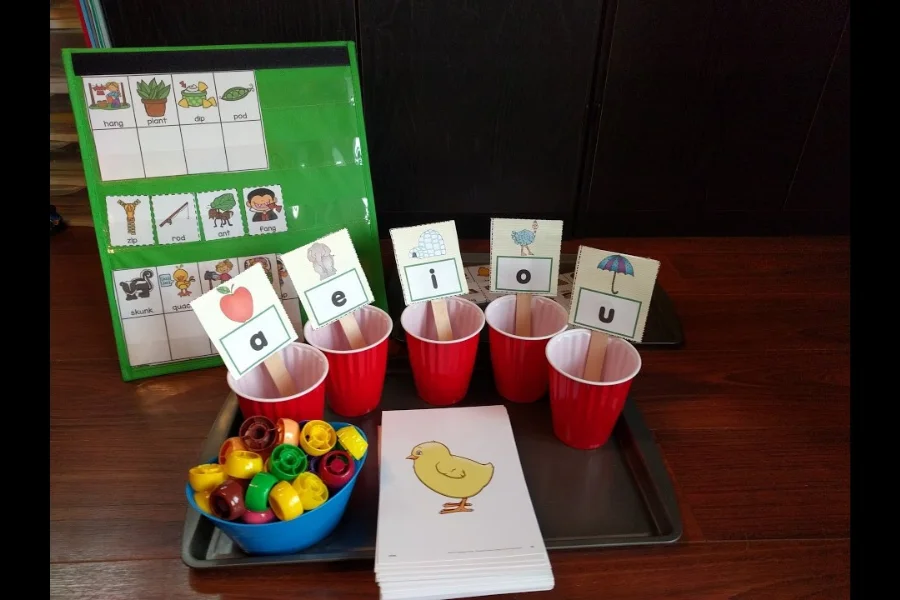
Source: slideshare
Long and Short Vowels, an integral part of Phonics teaching, play a significant role in evolving language skills. Long vowels sound like saying their letter names, whereas, short vowels have a shorter sound and do not say their letter names. The sound made by the vowel relies on its position in a word and the surrounding letters. A solid grasp of these sounds can greatly improve reading fluency and spelling accuracy, making it easier for learners to refine their linguistic abilities.
In this blog, we will discover how to recognize Long & Short Vowels and share effective teaching approaches to help students master these sounds.
For more details of Phonics Course Call / Whatsapp +919869866277/+919869546913
To Download Brochure of Phonics Course, Click Here!
What is Long and Short Vowels?
Long and Short Vowel denote the two unique sounds that vowel letters can signify in English words. A comprehension of these sounds helps in accurate reading and pronunciation.
Long Vowels
It is a long vowel when a vowel sounds the same way as its name.
For example:
- The letter ‘a’ in ‘bake’ (sounds like the letter name ‘A.’)
- The letter ‘e’ in ‘feet’ (sounds like the letter ‘E.’)
- The letter ‘i’ in ‘bite’ (sounds like the letter name ‘I.’)
- The letter ‘o’ in ‘home’ (sounds like the letter ‘O.’)
- The letter ‘u’ in ‘cute’ (sounds like the letter name ‘U.’)
Short Vowels
Short vowels, on the other hand, have a short and more compressed sound.
For example:
- ‘cat’- ‘a’ doesn’t sound like the letter ‘A’ and is short.
- ‘bed’- ‘e’ is short and doesn’t sound like the letter ‘E.’
- ‘sit’- ‘I’ is short and doesn’t sound like the letter ‘I.’
- ‘pot’- ‘o’ is short and doesn’t sound like the letter ‘O.’
- ‘cup’- ‘u’ is short and doesn’t sound like the letter ‘U.’
With these two types of vowel sounds, one can differentiate words and understand the pronunciation, which makes learning Long and Short Vowels important for students. It helps them read and spell words correctly.
What are the Rules of Vowels?
An understanding of the Rules of Vowels helps in evolving proficiency in phonics and refines pronunciation and reading skills.
Let us have a look at some key Rules of Vowels, with an emphasis on vowels:
Short Vowels
When followed by a consonant in a closed syllable, a vowel is usually short.
Examples: cat, bed, sit, dog, cup.
Rule: The vowel is usually short if only one vowel is present in a word or syllable and ends in a consonant.
Long Vowels
A vowel is long when it ‘says its name.’ This often happens in words where a vowel is followed by a silent ‘e’ (also known as the ‘magic e’ rule).
Examples: cake, bike, note, cute.
Rule: When there is a consonant after a vowel and then an ‘e’, the vowel generally turns out to be long.
Vowel Pairs (Vowel Digraphs)
When two vowels are present in pairs, the first vowel is usually long, and the second is silent.
Examples: boat, seed, rain.
Rule: ‘When two vowels go walking, the first one does the talking.’
By mastering these Rules of Vowels, readers and learners can boost their understanding of word pronunciation and spelling.
For more details of Phonics Course Call / Whatsapp +919869866277/+919869546913
To Download Brochure of Phonics Course, Click Here!

Source: vocus
How to Teach Long and Short Vowels?
To Teach Long and Short Vowels, engaging and effective approaches must be incorporated.
Here are some approaches to Teach Vowels:
Pay attention and Identify
Paying attention to words helps determine whether the vowel sound is short or long. This enhances children’s listening skills and helps them differentiate vowel sounds. For instance, make them say ‘kit’ to understand a short vowel and ‘kite’ to understand a long vowel.
Focus on Sounds
Highlight the sound of the vowel instead of its written form. For example, have students say ‘pin’ and ‘pine’ to notice the difference in vowel length.
Use Hand Motions
Incorporate hand gestures to make learning interactive. Hold arms out and arch upward for short vowels, and hold them straight out for long vowels.
Word Families
Use word families (‘hat,’ ‘fat,’ ‘cat,’ etc.) to teach short vowels, then familiarize words like ‘fate’ and ‘late’ for long vowels. This supports the relation between vowel sounds and spelling patterns.
CVC and VC Words
Teach CVC words (dog, nut, etc) for short vowels, and VC words (at, in, etc) for simpler short vowel examples.
Symbols
Use breve ( ˘ ) for short vowels and macron ( ¯ ) for long vowels as a visual representation.
By combining hearing, physical motions, and word families, students can effortlessly learn to differentiate between Long and Short Vowels, making the learning experience both interactive and fun.
Phonics Teacher Training
Phonics Teacher Training is a boon for ambitious educators who wish to help young learners master reading and spelling skills through sound-based practices. It equips teachers with the techniques to teach children the sounds of letters, blends, and Rules of Vowels, including Long and Short Vowels. By building this foundational knowledge, students can become expert readers and spellers.
Vidhyanidhi Education Society presents an extremely regarded Phonics Teacher Course, which trains educators to confidently teach phonics in a classroom setting. The course is designed to assist teachers in comprehending how to make phonics engaging and accessible for students.
Let us have a look at some of the benefits of Phonics Training:
Learning Phonics Rules
Vidhyanidhi’s Phonics Teacher Course helps teachers learn vowels, which form the basis for correct pronunciation and spelling.
Interactive Teaching Methods
The training introduces fun, interactive methods such as word games and sound exercises to keep students engaged.
Career Breaks
Completing this course can open up a wide range of career prospects in schools, tuition centers, or as a freelance phonics tutor.
Literacy Advancement
Teachers will be well-resourced to expand the literacy levels of their students, giving them a solid start in language learning.
Phonics Teacher Training is a priceless asset for any educator looking to specialize in early literacy skills.
Master Long and Short Vowels! Join Vidhyanidhi Education Society’s Phonics Course today!
For more details of Phonics Course Call / Whatsapp +919869866277/+919869546913
To Download Brochure of Phonics Course, Click Here!
FAQs
What are Examples of Long and Short Vowel?
Short vowels: cat, bed, sit, pot, cup.
Long vowels: cake, meet, kite, boat, cute.
How to Identify Long and Short Vowel?
Short vowels are quick (e.g., cat), while long vowels say their name (e.g., cake). Look at vowel patterns or silent 'e' endings.
How to become a Phonics Teacher?
Enroll in a phonics training course at Vidhyanidhi Education Society to gain expert knowledge and certification in phonics instruction.



